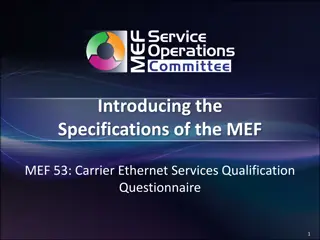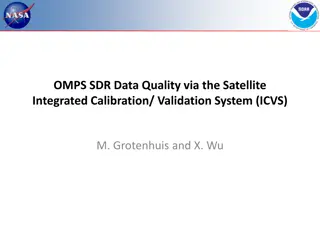Overview of GLAO Instrument Specifications and Sensitivities
The content discusses the GLAO instrument specifications and sensitivities as presented by Yosuke Minowa. It covers simulated instruments as of 2013, including wide-field NIR imaging, BB imaging, NB imaging, MOS spectroscopy, and more. A new instrument plan for a multi-object fiber IFU spectrograph utilizing Starbugs developed by AAO is outlined. Additionally, details on fiber throughput, fiber bundle configurations, and object multiplicity are provided for different setups.
Download Presentation

Please find below an Image/Link to download the presentation.
The content on the website is provided AS IS for your information and personal use only. It may not be sold, licensed, or shared on other websites without obtaining consent from the author.If you encounter any issues during the download, it is possible that the publisher has removed the file from their server.
You are allowed to download the files provided on this website for personal or commercial use, subject to the condition that they are used lawfully. All files are the property of their respective owners.
The content on the website is provided AS IS for your information and personal use only. It may not be sold, licensed, or shared on other websites without obtaining consent from the author.
E N D
Presentation Transcript
GLAO instrument specifications and sensitivities Yosuke Minowa
Simulated instruments as of 2013 Wide Field NIR imaging Broad-band (BB) imaging Narrow-band (NB) imaging Multi-Object Slit (MOS) spectroscopy Emission line Continuum KMOS type Multi-IFU spectroscopy Emission line
New Instrument Plan Multi-object fiber IFU spectrograph Fiber-bundle IFU system Utilize Starbugs developed by AAO Each bundle consists of 37, 19, 61 fibers within ~1.4, 1.0, 1.8 arcsec FOV.arcminute2FOV. Each fiber has 0.2 arcsec diameter.
Fibre throughput model fibre only, no coupling losses or FRD Wavelength (nm)
Fibre Bundle Configuration (1) Number of fibres 37 (7 fibres on an axis) Spatial sampling 0.2 arcsec / fibre Bundle sky diameter 1.4 arcsec (point to pint) Number of detector pixels per fiber 4 Number of pixels per bundle 148 Number of bundles per 2k detector 13 (1924 pixels; plus sky fibers?) Object Multiplicity (MOIRCS) 26 Sky Fibres/detector 30 sky fibres with 1 fibre gap
Fibre Bundle Configuration (2) Number of fibres 19 (5 fibres on an axis) Spatial sampling 0.2 arcsec / fibre Bundle sky diameter 1.0 arcsec (point to pint) Number of detector pixels per fiber 4 Number of pixels per bundle 76 Number of bundles per 2k detector 26 (1976 pixels; plus sky fibers?) Object Multiplicity (MOIRCS) 52 (feasible??) Sky fibres /detector 17 sky fibres with a 1 fibre gap
Fibre Bundle Configuration (3) Number of fibres 61 (9 fibres on an axis) Spatial sampling 0.2 arcsec / fibre Bundle sky diameter 1.8 arcsec (point to point) Number of detector pixels per fiber 4 Number of pixels per bundle 244 Number of bundles per 2k detector 8 (1952 pixels; plus sky fibers?) Object Multiplicity (MOIRCS) 16 Sky fibres/detector 23 sky fibres plus 1 fibre gap N=61 bundle (Bryant et al. 2014, MNRAS 438, 869)
Instrument setup Starbugs unit will be attached to the Cassegrain focus Spectrograph will be placed at the observation floor or at Nasmyth platform and connected to the starbugs with fibers. F-conversion might be necessary to reduce the F# (12.4 (e.g. 3.0) and avoid the effect of FRD(?) Throughput of the fiber will be (e.g. 90%@NIR). Fiber will be connected to the fiber slit in the focal plane module, which is placed in the cryogenic condition. Minimum spacing in between fiber centers should be 4 pixels or larger and the minimum spacing between the 90% EE diameter of each adjacent fiber should be 1 pixel or larger to avoid significant cross-talk and ensure the accuracy of the sky subtraction (<0.5%? based on PFS study). F-conv. optics in side of the FP module might be necessary to change the F# back to the original (12.4) or to the optimum number for the spectrograph.
Phase-I: Starbug+ New MOIRCS First light instrument for GLAO Commissioning obs. will start from around 2017? Observations with OH suppression 2020?. Number of bundles: (1) HK500, zJ500, R1300+BB(JHK), VPH: 26 (config 1); 52 (config 2); 16 (config 3) (2) R1300 or VPH + Narrow-band or Intermediate band filters: 78 (config 1); 156 (config 2); 48 (config 3) Sensitivity: 60-70% of MOSFIRE/Keck (MOIRCS VPH only) Sensitivity: 75- 85% of KMOS/VLT (MOIRCS VPH only) Need to multiply by 70-80% efficency for fiber system MOIRCS will be moved to the observation floor or Nasmyth platform and connected to the starbugs with fibers. Focal plane unit of MOIRCS will be modified so as to feed the light into slits from fibers.
Phase-II: Starbug +new dedicated instrument First light will be several years after GLAO commissioning Number of bundles: 52 (config 1); 104 (config 2); 32 (config 3) for each spectrograph! 13 .5 FOV Sensitivity: 70-80% of MOSFIRE/Keck Sensitivity of the spectrograph should be same as or higher than MOSFIRE. Only difference is throughput and emissivity due to the fibers. Not including telescope diameter difference New instrument will be placed on the observation floor or Nasmyth platform and connected to the starbugs with fibers.
Sensitivity comparison with MOSFIRE MOIRCS MOSFIRE Current New FOV 4 x7 6 .1x6 .1 Imaging throughput (atm+Telescope+Instrument) 0.23(J), 0.34(H),0.30(K) 0.54(J),0.56(H),0.50(K) Spectral resolution 500, 1300, ~3000(VPH)* 3500 HK500, zJ500: 0.8(J), 0.78(H), 0.65(K) R1300: 0.2(J), 0.3(H), 0.5(K) VPH: ~0.75(J), ~0.7(H) 0.80(K) 0.60(J), 0.65(H),0.70(K) Grating diffraction efficiency HK500, zJ500: 0.18(J), 0.26(H), 0.20(K) R1300: 0.05(J), 0.10(H), 0.15(K) VPH: ~0.15(J), ~0.20(H), ~0.26(K) Spec. throughput (atm+Telescope+Instrument) 0.325(J), 0.361(H), 0.350(K) Detector HAWAII-2 HAWAII-2RG HAWAII-2RG QE ~80%(JHK) ~80%(JHK) 15e rms (16NDR) Read-out noise 5e rms (16NDR) 5e rms (16NDR) * For 0.5 slit. Using a fiber with 0.2 spatial sampling, resolutions are 2.5 times higher.
Sensitivity Improvement of MOIRCS HAWAII2 => H2RG Readout noise: 15e- => 5e- Grism replacement System throughput: 15%(R1300) => 25%(R2000) Sharp and stable image with GLAO Improvement of emission line sensitivity Point source: >1.2 mag. (>3x) Extended source: ~0.5 mag. (~1.6x)
Sensitivity comparison with MOSFIRE Current MOIRCS sensitivity is 4~7 times lower than MOSFIRE (difference in the telescope diameter is not taken into account). If the new MOIRCS can successfully reduce the RO-noise down to 5e-, the sensitivity difference is about 1.4(VPH)~2.3(R1300). This difference can not be reduced without changing the optical coating. MOSFIRE has 31 surfaces Average throughput in each surface is about 0.992. Total throughput of the optical coating is about 0.78 MOIRCS has 24 surfaces. Average throughput of the coating is 0.983. Total throughput of the coating is 0.64.























